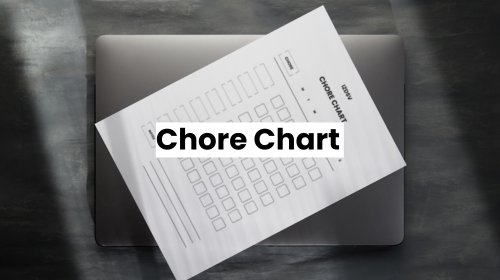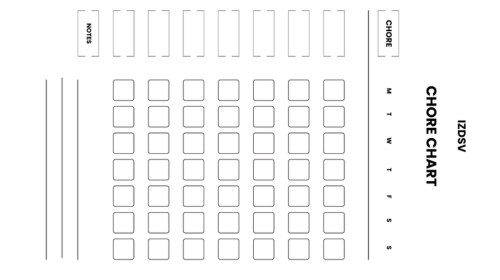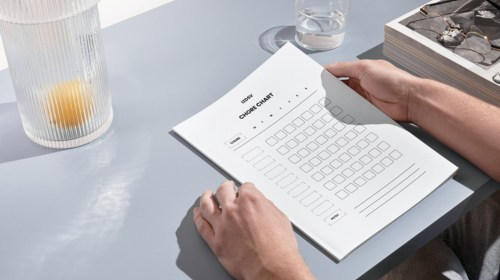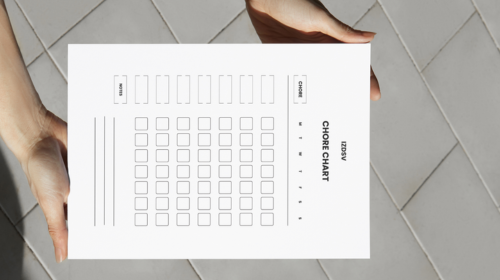Organize Your Home with Our Printable Chore Chart
Why Use a Minimalist Printable Chore Chart?
A minimalist printable chore chart is a valuable tool for household management for several key reasons:
- Task clarity: It clearly defines what tasks need to be done, eliminating confusion or oversight.
- Fair distribution: It helps ensure an equitable division of labor among household members.
- Accountability: By assigning tasks, it creates a sense of responsibility for each person.
- Routine establishment: It helps create and maintain regular household maintenance habits.
- Conflict reduction: Clear assignments can minimize arguments about who should do what.
- Time management: It allows for better planning and scheduling of household tasks.
- Progress tracking: It provides a visual representation of completed and pending tasks.
- Skill development: For children, it can teach important life skills and time management.
- Household efficiency: It can lead to a more organized and smoothly running household.
- Stress reduction: Knowing tasks are planned and distributed can alleviate anxiety about household upkeep.
What Are the Benefits of Having a Minimalist Printable Chore Chart?
A minimalist printable chore chart offers several specific benefits:
- Visual clarity: The simple design reduces clutter and makes tasks easily recognizable at a glance.
- Ease of use: With fewer elements, it’s quicker and more straightforward to update and maintain.
- Reduced overwhelm: A minimalist design can make the task list feel less daunting.
- Flexibility: Simple designs are often more adaptable to different household needs and can be easily modified.
- Cost-effective: Minimalist designs typically use less ink when printing, saving on resources.
- Time-saving: The straightforward layout allows for quick task checking and assignment.
- Focus on essentials: It encourages prioritizing the most important tasks without unnecessary extras.
- Aesthetic appeal: A clean, minimalist design can blend well with various home decor styles.
- Reduced distractions: Fewer graphical elements mean users can focus solely on the tasks at hand.
- Accessibility: Simple designs are often easier to read and understand for all family members, including children.
- Eco-friendly: Minimalist designs often require less paper if you need to print multiple copies or versions.
- Stress reduction: A clutter-free chart can contribute to a sense of calm and order in the household.
How Can a Minimalist Printable Chore Chart Help You Stay Organized?
A minimalist printable chore chart can significantly enhance your organizational efforts in several ways:
- Visual simplicity: The clean design provides a clear, at-a-glance view of tasks, making it easier to process information quickly.
- Focus on essentials: It helps prioritize key tasks without overwhelming you with excessive details.
- Easy tracking: With a streamlined layout, you can quickly mark completed tasks and identify what’s left to do.
- Consistency: It encourages regular task completion by providing a constant, visible reminder.
- Time management: The clear layout helps in planning and allocating time for each task efficiently.
- Reduced mental load: Having tasks clearly laid out reduces the need to remember everything, freeing up mental energy.
- Adaptability: Simple designs are often easier to modify as your needs change, helping maintain long-term organization.
- Habit formation: Regular use of the chart can help establish and reinforce positive organizational habits.
- Accountability: It provides a tangible record of task completion, promoting responsibility and follow-through.
- Decluttering: The minimalist approach can inspire a more organized, clutter-free approach to other areas of life.
- Stress reduction: Knowing tasks are organized and planned can alleviate anxiety about household management.
- Family coordination: It serves as a central point of reference for all household members, improving overall organization.
Who Can Benefit from Using a Minimalist Printable Chore Chart?
A minimalist printable chore chart can benefit a wide range of individuals and groups:
- Busy families: Parents and children can use it to divide and track household responsibilities.
- Working professionals: It helps manage household tasks alongside career demands.
- Students: Assists in balancing academic work with personal responsibilities.
- Roommates: Helps fairly distribute and track shared living space maintenance.
- Couples: Promotes equal division of household labor and reduces potential conflicts.
- Single individuals: Aids in maintaining a structured approach to home care.
- People with ADHD: The clear, uncluttered format can help with task focus and completion.
- Elderly individuals: Provides a simple way to remember and track daily tasks.
- Caregivers: Helps organize care routines for those they’re assisting.
- Individuals with anxiety: The structured approach can reduce stress about household management.
- People in therapy: Can be used as a tool for developing better habits and routines.
- Children learning responsibility: Teaches task management and accountability.
- Minimalists: Aligns with a simplified lifestyle approach.
- Visual learners: Benefits those who process information better through visual means.
- Time management enthusiasts: Adds another tool to their organizational toolkit.
How to Create an Effective Minimalist Printable Chore Chart
- Choose a simple, clean layout
- Use clear, legible fonts
- Include only essential information
- Employ a logical task organization system
- Ensure ample white space for readability
What Elements Should Be Included in Your Chore Chart?
- Task names
- Frequency (daily, weekly, monthly)
- Assigned person (if applicable)
- Completion checkbox or space
- Date or day of the week
How Do You Customize a Chore Chart for Your Family?
- List tasks specific to your household needs
- Consider age-appropriate chores for children
- Balance task distribution among family members
- Incorporate personal or family goals
- Allow for flexibility in scheduling
What Are Some Creative Ideas for Chore Chart Design?
- Color-coding for different family members or task types
- Use of simple icons or symbols for tasks
- Magnetic or dry-erase boards for easy updating
- Digital versions for tech-savvy families
- Incorporate a reward system or progress tracker
Using Minimalist Printable Chore Chart
Using a minimalist printable chore chart effectively can greatly improve household organization. Here’s a guide on how to make the most of your chart:
- Introduction and setup:
- Print the chart and place it in a visible, central location
- If reusable, consider laminating or using a page protector
- Initial family meeting:
- Explain the chart’s purpose and benefits
- Discuss and assign tasks together
- Ensure everyone understands their responsibilities
- Daily use:
- Encourage family members to check the chart each morning
- Mark completed tasks promptly
- Use as a visual reminder throughout the day
- Weekly review:
- Hold a brief family meeting to discuss the week’s progress
- Celebrate successes and address any challenges
- Make adjustments to tasks or assignments if needed
- Consistency and habit-forming:
- Stick to the chart for at least a month to form habits
- Lead by example in using and referring to the chart
- Refreshing the chart:
- Update weekly or monthly as needed
- Rotate tasks periodically to prevent boredom
- Motivation and rewards:
- Consider implementing a simple reward system
- Acknowledge and praise consistent chart use
- Troubleshooting:
- Address any resistance or non-compliance promptly
- Be open to feedback and willing to make adjustments
- Integrating with other systems:
- Use alongside a family calendar or meal planner
- Sync with digital reminders if helpful
- Teaching moments:
- Use the chart to discuss responsibility and time management
- Help younger children learn to read and follow the chart
The key to success is consistency and positive reinforcement. The chart should be a helpful tool, not a source of stress or conflict.
How Do You Utilize the Chore Chart Effectively in Your Home?
Utilizing a chore chart effectively in your home involves several key strategies:
- Consistent placement:
- Keep the chart in a high-traffic area like the kitchen or family room
- Ensure it’s easily visible and accessible to all family members
- Daily check-ins:
- Establish a routine of checking the chart each morning or evening
- Encourage family members to mark completed tasks immediately
- Lead by example:
- Parents or household leaders should actively use and reference the chart
- Demonstrate enthusiasm for completing tasks and marking them off
- Regular family meetings:
- Hold weekly meetings to review progress and address any issues
- Use this time to celebrate successes and problem-solve challenges
- Positive reinforcement:
- Praise family members for completing tasks and using the chart
- Consider implementing a simple reward system for consistent participation
- Flexibility and adjustments:
- Be open to modifying tasks or schedules as needed
- Regularly assess if the current system is working for everyone
- Age-appropriate involvement:
- Assign tasks suitable for each family member’s abilities
- Help younger children understand and use the chart
- Combine with other organizational tools:
- Integrate the chore chart with family calendars or meal planners
- Use digital reminders to supplement the physical chart if helpful
- Rotate responsibilities:
- Periodically switch up task assignments to prevent boredom
- This also ensures everyone learns various household skills
- Use as a teaching tool:
- Discuss the importance of each task and how it contributes to the household
- Use the chart to teach time management and responsibility
- Make it interactive:
- Allow family members to check off their own tasks
- Consider using stickers or colored markers to make it engaging
- Regular updates:
- Refresh the chart weekly or monthly to keep it current
- Add or remove tasks as household needs change
Tips for Maintaining Your Minimalist Printable Chore Chart
Here are some concise tips for maintaining a minimalist printable chore chart:
- Keep it simple – focus on essential tasks only
- Use clear, minimal design with plenty of white space
- Laminate the chart for durability and reusability
- Use dry-erase markers to check off completed chores
- Review and update tasks monthly
- Place the chart in a visible, high-traffic area
- Involve all household members in using the chart
- Pair with a reward system for motivation
- Use icons or symbols instead of text where possible
- Limit color palette to 2-3 colors maximum
How Often Should You Update Your Minimalist Chore Chart?
To maintain an effective minimalist chore chart, you should update it regularly. Here’s a concise guide on how often to update different aspects:
- Daily: Check off completed tasks
- Weekly:
- Reset the chart for the new week
- Make minor adjustments to daily/weekly tasks in the weekly chore chart
- Monthly:
- Review overall effectiveness
- Add or remove tasks based on current needs
- Reassess task assignments among household members
- Seasonally (every 3-4 months):
- Add or remove season-specific chores
- Reevaluate the chart’s design and layout
- Annually:
- Conduct a major review of all tasks and systems
- Consider creating a new chart design
- As needed:
- When family circumstances change (e.g., new baby, job change)
- If you notice the current system isn’t working well
The key to a minimalist chore chart is flexibility and simplicity. Regular updates help maintain its effectiveness without overcomplicating the system.
What Strategies Can Help Keep Everyone Accountable?
To keep everyone accountable with a minimalist chore chart, consider these strategies:
- Clear assignments: Designate specific tasks for each person.
- Visual cues: Use colors or symbols for each family member.
- Daily check-ins: Brief family meetings to review progress.
- Rotation system: Regularly swap chores to maintain fairness.
- Positive reinforcement: Offer praise or small rewards for consistency.
- Natural consequences: Let undone chores affect only the responsible person.
- Lead by example: Adults should model consistent chart use.
- Digital reminders: Use apps or shared calendars for tech-savvy families.
- Buddy system: Pair up family members for mutual accountability.
- Weekly review: Discuss successes and challenges as a group.
- Gradual responsibility: Increase children’s tasks with age.
- Flexibility: Allow task-swapping when needed, maintaining overall fairness.
How Can You Make Chores More Fun for Kids?
Making chores fun for kids can significantly increase their engagement and willingness to participate. Here are some effective strategies:
- Gamification:
- Create a points system for completed chores
- Use a “beat the clock” challenge for time-based tasks
- Implement levels or ranks for consistent performance
- Music and movement:
- Play upbeat music during chore time
- Have a family clean-up dance party
- Choice and autonomy:
- Let kids choose some of their tasks
- Allow them to decide the order of their chores
- Team effort:
- Work alongside your kids
- Create parent-child or sibling teams for larger tasks
- Creative tools:
- Use fun cleaning tools like colorful dusters or squeegees
- Let kids wear superhero capes while doing chores
- Storytelling and imagination:
- Create narratives around chores (e.g., “defeat the dust bunnies”)
- Pretend play (e.g., being a robot programmed to clean)
- Reward system:
- Offer small, immediate rewards for task completion
- Use a sticker chart leading to a larger reward
- Make it educational:
- Turn sorting laundry into a color-matching game
- Use counting or math while putting away dishes
- Rotate “Chore Captain”:
- Let kids take turns being in charge of delegating tasks
Take the First Step Toward an Organized Home
Taking that first step towards an organized home is crucial, and a chore chart template can be an excellent tool to kickstart the process. Let’s break down how to begin your chore chart journey:
- Assess your needs:
- List all necessary household tasks
- Identify problem areas or current pain points
- Assign tasks:
- Distribute chores fairly among family members
- Consider age-appropriate responsibilities
- Set a schedule:
- Determine the frequency for each task (daily, weekly, monthly)
- Decide on specific days/times for certain chores
- Implement a trial period:
- Start with a 2-week test run
- Be open to adjustments
- Gather supplies:
- Get any necessary cleaning tools
- Prepare rewards or incentives if using them
- Family meeting:
- Introduce the family chore chart to everyone
- Explain the system and address any questions
- Start small:
- Begin with a few key tasks
- Gradually add more as the habit forms
- Commit to consistency:
- Use the chart daily
- Lead by example




